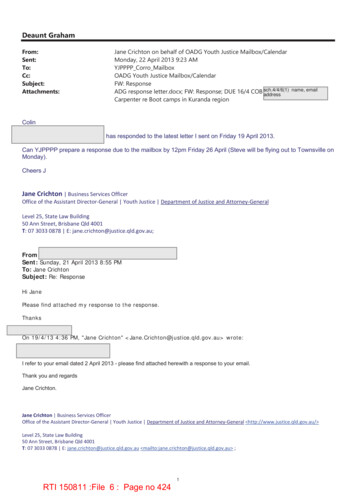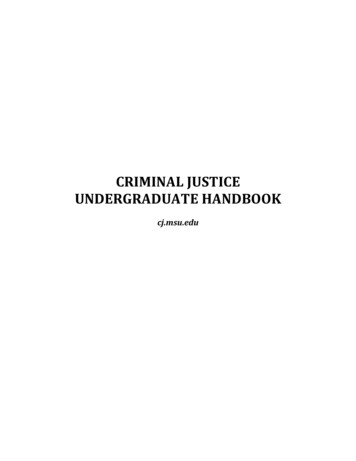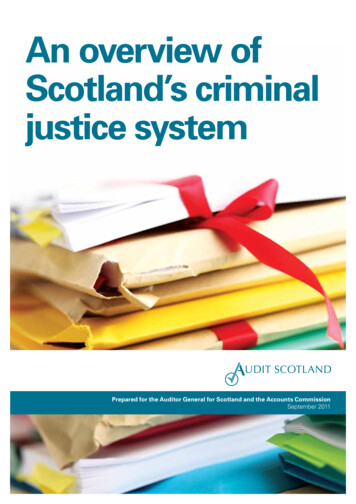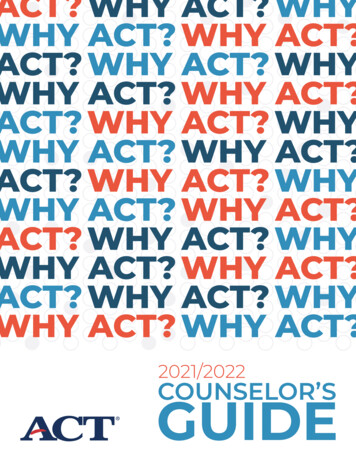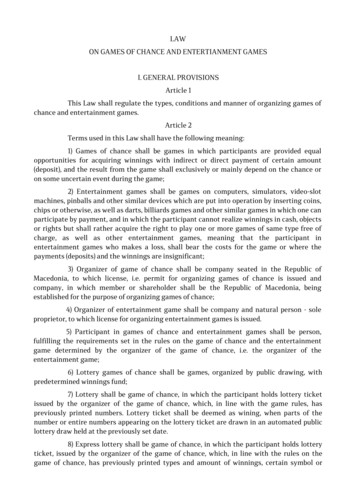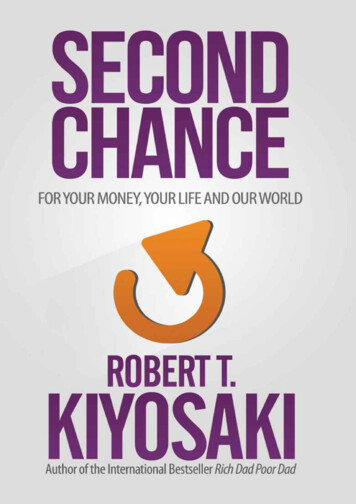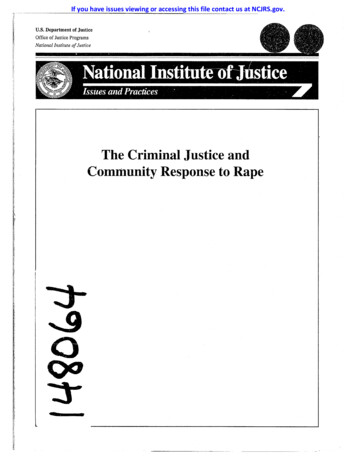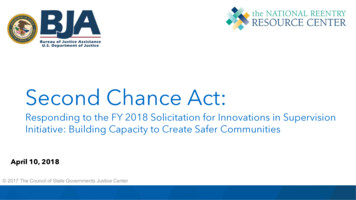
Transcription
Second Chance Act:Responding to the FY 2018 Solicitation for Innovations in SupervisionInitiative: Building Capacity to Create Safer CommunitiesApril 10, 2018 2017 The Council of State Governments Justice Center
Speakers DeAnna Hoskins, Senior Policy AdvisorCORRECTIONS AND REENTRY, BUREAU OF JUSTICE ASSISTANCE Blaine Stum, Policy AnalystCORRECTIONS AND REENTRY, THE COUNCIL OF STATE GOVERNMENTS JUSTICE CENTER2
Overview IntroductionGrant Program OverviewProgram Requirements & ExpectationsApplication & Selection CriteriaResources & Important Contacts3
Poll of AttendeesWe’d like to find out more about who’s on the line.In your right-hand column at the bottom, you will see the question:Please indicate the type of organization you represent: Category 1: State governmentCategory 1: Local governmentCategory 1: Federally recognized Indian tribal government Category 2: National-scope private and nonprofit organizationCategory 2: Tribal nonprofit or for-profitCategory 2: College and UniversityCategory 2: Tribal Institution of Higher Education4
The Council of State GovernmentsJustice Center A national non-profit, non-partisan membership association of stategovernment officialsEngages members of all three branches of state governmentProvides practical, nonpartisan advice informed by the best availableevidence5
Authorized by the passage of the Second Chance Act in April2008 Launched by the Council of State Governments Justice Centerin October 2009 Administered in partnership with the Bureau of JusticeAssistance, U.S. Department of Justice The NRRC has provided technical assistance to over 600 juvenileand adult reentry grantees since its inception6
NRRC Website7
SCA Innovations in Supervision Initiative44 AWARDS ACROSS THE NATION15 County Grantees25 State Grantees4 City GranteesFY12FY13FY14FY15FY16FY178
SCA Innovations in SupervisionInitiative Grant ProgramTotal # of Grant AwardsFY 2017Total Amount AwardedFY17 - 4,997,761.007FY 2016FY16 - 5,306,912.008FY 20157FY15 - 4,771,344.00FY 20147FY14 - 4,558,858.00FY 2013FY13 - 3,837,793.006FY 2012FY12 - 3,675,366.00902468109
The Second Chance Act:Current Funding Opportunities Innovations in Supervision Initiative: Building Capacity to Create SaferCommunities: Second Chance Act Comprehensive Community-Based Adult Reentry ry18.pdf10
Poll of AttendeesWe’d like to find out more about who’s on the line.In your right-hand column at the bottom, you will see thequestion:Have you previously applied for an SCA grant? Yes No11
Overview IntroductionGrant Program OverviewProgram Requirements & ExpectationsApplication & Selection CriteriaResources & Important Contacts12
Bureau of Justice AssistanceMission: BJA’s mission is to provide leadership and servicesin grant administration and criminal justice policydevelopment to support local, state, and tribal justicestrategies to achieve safer communities.The Second Chance Act hassupported over 300 millionin reentry investments acrossthe countryhttps://www.bja.gov/13
FY18 ISI Category 1Improving Supervision to Reduce Crime and Recidivism Category 2Collaborating with Supervision Agencies to Reduce Crime andRecidivism14
Award Information Category 1 - 650,000 (up to threeawards) Category 2 - 2,000,000 (one award) 36-month period15
Innovations in Supervision Initiative GoalGoal:Increase probation/parolesuccess ratesReduce the number ofcrimes committed by thoseunder probation/parolesupervision16
Overview IntroductionGrant Program OverviewProgram Requirements & ExpectationsApplication & Selection CriteriaResources & Important Contacts17
Eligibility: Category 1 States, units of local government, and federally recognizedIndian tribal governments (as determined by the Secretary ofthe Interior) Two or more entities may carry out the award; applicant mustbe the entity with primary responsibility for the award18
ISI Category 1: ObjectivesSupport uceRecidivism andViolent Crime Align agencypractices withevidencebased practices Assess anddocument theprocess andoutcomes Target people witha high risk ofrecidivating &higher risk ofcommittingviolenceEstablish qualityprograms officers to beagents of behaviorchangeImplement CQI1919
ISI Category 1: DeliverablesAction Plan(through completion of a Planning& Implementation Guide)Analysis andResearch Problem analysis Program and evaluation model Summary of strategies and intended outcomes Research base for proposed strategies Mid-term analysis and research report at 18months Final analysis and research report20
Action ResearchApplyfindings tocurrentprocessCommunicateFindingsCollect andAnalyzeResultsIdentify theproblemDesign aresearch planImplementresearch plan21
Eligibility: Category 2 National-scope private and nonprofit organizations(including tribal nonprofit or for-profit organizations) Colleges and universities, both public and private(including tribal institutions of higher education)22
ISI Category 2: ObjectivesTTA ProgramSelection ProcessSub-Awards Provide assistance toprobation agenciesand their partners todevelop/implementstrategies to reducerecidivism and crimeamong superviseesat high risk ofcommitting violence Select three teams -composed of aprobation or paroleoffice (lead), a lawenforcement orprosecution office,and a researchpartner, if applicable -to receive TTA Make and administersub-awards of 500,000 to thethree selected teamsto supportimplementation23
ISI Category 2: ObjectivesModel and Guide Develop a model andguide for howcorrections agenciescan effectively workwith lawenforcement andprosecutor partnersto address crime andhold offendersaccountablePerformance andEvaluation Assist teams todevelop and trackperformance measuresand an evaluationstrategyDocument Documentimplementationlessons learned PublicationsReportsWebinarsOther resources24
ISI Category 2: DeliverablesGuide andModel A model and guide forprobation/parole to partner with lawenforcement and prosecutingagencies to prevent recidivism andviolent crime Dissemination of model25
Award Special Condition Withholding of all but 200,000 Development of an action plan within 180days of budget approval– Entails completion of a comprehensive projectwork plan based on a Planning & ImplementationGuide (P&I Guide)26
Overview IntroductionGrant Program OverviewProgram Requirements & ExpectationsApplication & Selection CriteriaResources & Important Contacts27
SCA Innovations in SupervisionInitiatives Grant ProgramSolicitation is available pdfApplications due on May 1, 2018.28
Review CriteriaBudget10%Plan for Data Collection of Performance Measures5%Capabilities & Competencies30%Project Design & Implementation40%Description of Issue15%0%5%10%15%20%25%30%35%40%45%Percent of Total Score29
Additional AttachmentsCategory 1Timeline/project planLetter from community supervision agency executiveLetter from lead agencyLetter from research partner (if applicable)Letters of support from all other key stakeholdersAssurance to collect and submit recidivism indicator dataApplicant disclosure of pending applicationsResearch and evaluation independence and integrityDisclosure of process related to executive compensation30
Additional AttachmentsCategory 2Timeline/project planLetters of support from all other key stakeholdersPosition descriptionsResumes or curricula vitarumExamples of work productsApplicant disclosure of pending applicationsResearch and evaluation independence and integrityDisclosure of process related to executive compensation31
Poll of AttendeesWe’d like to find out how helpful these webinars are.In your right hand column at the bottom, please provide aresponse to the following:I found this webinar helpful.1 Strongly Disagree2 Disagree3 Neutral4 Agree5 Strongly Agree32
Overview IntroductionGrant Program OverviewProgram Requirements & ExpectationsApplication & Selection CriteriaResources & Important Contacts33
Resources Office of Justice Programs Crime Solutions website (https://www.crimesolutions.gov/) National Implementation Research Network website (http://nirn.fpg.unc.edu/) A Ten Step Guide to Transforming Probation Departments to Reduce Recidivism, Council ofState Governments Justice /1150/A TenStep Guide to Transforming Probation Departments to Reduce Recidivism.pdf) Recommendations for Collaborating Successfully with Academic Researchers, Findings fromthe Researcher-Practitioner Partnerships 43911.pdf)34
Contact InformationFor questions about the process of submitting an application: Contact the Grants.gov Customer Support Hotline at 800-518-4726, 606-545-5035, athttps://www.grants.gov/web/grants/support.html, or at support@grants.gov. TheGrants.gov Support Hotline operates 24 hours a day, 7 days a week, except on federalholidays.For assistance with unforeseen Grants.gov technical issues beyond an applicant’s control: Contact the National Criminal Justice Reference Service (NCJRS) Response Center at800-851-3420, via TTY at 301-240-6310 (hearing impaired only), email grants@ncjrs.govor web chat at https://webcontact.ncjrs.gov/ncjchat.jsp. NCJRS Response Center hoursare 10 a.m. to 6 p.m. ET, Monday-Friday, and 10 a.m. to 8 p.m. ET on the solicitationclose date.35
Questions and Answers36
Thank you!Join our distribution list to receiveNational Reentry Resource Center updates!www.csgjusticecenter.org/subscribeFor more information, contactinfo@nationalreentryresourcecenter.orgThis presentation was prepared by The Council of State Governments (CSG) Justice Center, in partnership with the U.S. Department of Justice’s Bureau of Justice Assistance. Presentationsare not externally reviewed for form or content. The statements reflect the views of the authors and should not be considered the official position of the CSG Justice Center, the membersof The Council of State Governments, or the Bureau of Justice Assistance.
ISI Category 2: Objectives 24 Model and Guide Develop a model and guide for how corrections agencies can effectively work with law enforcement and prosecutor partners to address crime and hold offenders accountable Performance and Evaluation Assist teams to develop and track per
